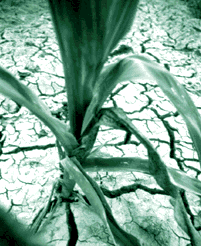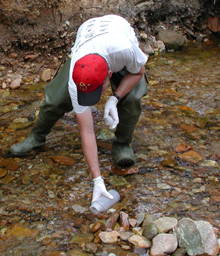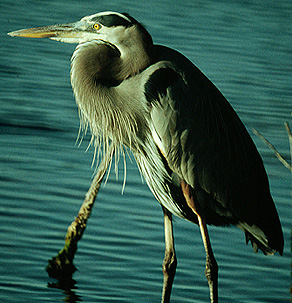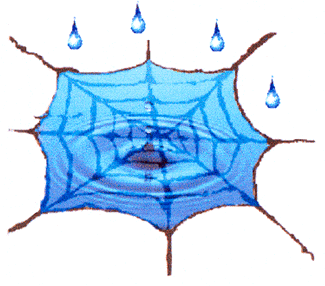Maryland Water Resources Research Center
Water on the Web
|
|
Table of Contents: |
|
|
|
|
||
|
|
||
|
|
||
|
|
||
|
|
|
|
Purpose: The site is intended for any one who has an interest in Maryland water, i.e. Homeowners, Students, Farmers, Watermen, State and Local Administrators, and Residents. For being such a small state, there is an amazing amount of information on our Maryland water resources. Below, there is a listing of sites concerning the above topics, as well as a brief commentary on the content of each site. These listings do not cover in any detail the large amount of information on the Chesapeake Bay.
If you have any other web resources to offer, we would appreciate hearing about other water sites of local interest. Contact us at apdavis@umd.edu or kearneyp@umd.edu.
Sources: The
websites shown below come
from many sources, the following alphabetical list of abbreviations
should be helpful:
MDNR - Maryland Department of Natural Resources
MARFCHP - The Middle Atlantic River Forecast, National Weather Service
MDE- Maryland Department of the Environment
MPA - Maryland Port Authority
PGCO - Prince George's County Planning Board
SMCM - St. Mary's College of Maryland
UMCP - University of Maryland, College Park, College of Agriculture and Natural Resources
USACE - U.S. Army Corp of Engineering
USDA - U.S. Department of Agriculture
USEPA - U.S. Environmental Protection Agency
USGS - U.S. Geological Survey
WATER - Water Use It Wisely Webpage
To view information concerning all of the Chesapeake Bay Watershed. Please visit www.chesapeakebay.net. This is an excellent webpage that includes information regarding the topics mentioned above.
Water on the web
Baltimore Harbor Anchorages and Channels Project:One example of dredging project in Baltimore.
Dredging the Chesapeake Bay: This informative news article focuses on the debate of dredging the Chesapeake Bay.
Corn Plant Under Drought Stress.
From NOAA's Drought Information Center.
Drought

Palmer Drought Index map of the United
States.
Water Watch (USGS): This webpage has information on water resources, including real-time
data from select areas throughout the state of Maryland. Drought and flood watches can be found here as well.
MDE:
This website provides information for residents of the state of Maryland regarding drought emergencies.
Water Conservation: This site gives information on how you can help with
serious droughts in the state of Maryland through water conservation.
Drought Monitor: A site that has great links to other drought resources.
USEPA: Welcome
to the EPA Student Center, another great educational site with
extensive teaching materials. Here the student can learn how water is
polluted, treated, and protected. It also has some spectacular interactive
graphs that allows the student, for example, to follow each step of
the water treatment process.
MDNR: A link that
provides educational links to teachers in regards to natural resources
in the state of Maryland.
MD:Educational information on Maryland's Bays and Streams.
WATER: A link that focuses on ways to conserve water.
 |
|
Boating on Maryland's Lakes - A Favorite Form of Recreation |
MDNR: Maryland State Forest and Park Service site with water related recreational activities in Maryland's 47 state parks
USACE: The Jennings Randolph Lake is located in Garrett County and provides a campground, two overlooks, a picnic area and boat launch. Special events include whitewater release schedules. Come see one of the best kept secrets in the State-Western Maryland!
MDNR: If you register your boat in Maryland, the MDNR has put together some information that will help when the time comes to process your paper work. There are a number of other recreational activities carried by this site, including the very popular "2000 Bay Game" for kids riding along U.S. 50 and MD 404 to the Eastern Shore beaches. Game available at Bay Bridge toll booths.
LOC-Fishing:
A very large
site with multiple links for up-to-date fishing information along the
Maryland/Delaware Atlantic coast.
USGS Scientist Samples Stream
for Water Quality USGS: Report-Extensive
coverage of water quality by the Lower Susquehanna River Basin Study
Unit, including nitrates, radon in groundwater, volatile organic
compounds and bacteriological quality. During droughts, Maryland takes
water from the Susquehanna to fill local reservoirs.
LOC-Surfing: Yes -
you can go surfing on the Maryland and Delaware Atlantic beaches, and
the Eastern Surfing Association has a lot of information at this site
on this popular water sport.
Water Quality

MDE:
Maryland Department of the Environment is concluding a review water
quality standards. A final report from the Septic System Advisory
Committee was due in January 2000. Septic systems are one source of
nutrient pollution of Maryland water systems.
MDE:
Large number of news releases on improving local Maryland water
systems and extensive coverage of the impact of April 7, 2000 oil
spill of 111,000 gallons of fuel oil into Swanson Creek along the
Patuxent River.
PGCO: The Prince George's County Planning Board outlines it's work program, which includes a Water Resources Policy/Surface Water Quality Program
SMCM:
St. Mary's College, in cooperation with the Maryland Environmental
Service, conducted over 800 tests for 120 compounds and found that
College drinking water met all State and Federal requirements for
safety. Chemical analysis is provided.
EPA: Drinking Water and Health: What you need to know about your drinking water and health related issues, an extensive list of contaminates regulated by EPA with information on each of those contaminates and information on setting standards for safe drinking water.
EPA: An extensive list of frequently asked questions about drinking water quality, and where to go to get more information about specific issues raised by these questions.
MDE: The Maryland Source Water Assessment Program, currently being conducted by the Maryland Department of the Environment, is probably the largest water survey ever conducted in the State. It will use three tools to determine the safety of more than 3,700 public drinking water systems. These three steps include: delineating the drainage area likely to contribute to the drinking water supply, identifying potential contaminants within that area, and assessing the vulnerability of the system to those contaminants. There has been extensive public input into this project.
USACE: The Jennings Randolph Lake in Garrett County supplies water in times of shortage to the Washington Suburban Sanitary Commission, the Fairfax County Water Authority and the District of Columbia.
USGS: Detailed report on United States water sources and delivery systems from a 1990 survey. This is a good overview picture of water withdrawls across the US and particularly in three of the largest use areas in the country, which includes the Mid Atlanic region.
PGCO: The
Prince George's County Planning Board includes Watershed Planning
and Implementation as part of it's work program.
USEPA:
Very large
site dealing with assistance grants for watershed improvement
projects, examples of stream corridor restoration projects, in-depth
discussion of the total maximum daily load program and of local
interest; the Anacostia and Patuxent River Watershed projects.
USGS: USGS
investigates watersheds at scales that range from the small research
watersheds of the Water, Energy, and Biogeochemical Budget (WEBB)
Program to the Nation's largest watersheds with data collected as
part of the National Stream Quality Accounting Network (NASQAN). Of
local interest is a project under the Other Small Research Watersheds
program, which includes a small watershed in the Catoctin Mountains
with extensive chemical analysis of water collected at this site.
Great Blue Heron USDA:
This constructed
wetlands bibliography, compiled by the United States
Department of Agriculture's Natural Resources Conservation Service
(formerly the Soil Conservation Service) and the Water Quality
Information Center at the National Agricultural Library at Beltsville
MD, consists of more than 600 citations. One hundred and sixty-one of
these have abstracts. This and the next site may be all you will ever
want to know about wetlands. USEPA: EPA's extensive
coverage of wetlands, including definitions, types, function and value,
and status and trends. Much of Maryland's attention is focused on the
Chesapeake Bay's wetlands and there role in nutrient reduction and
aquatic habitat.
Wetlands

